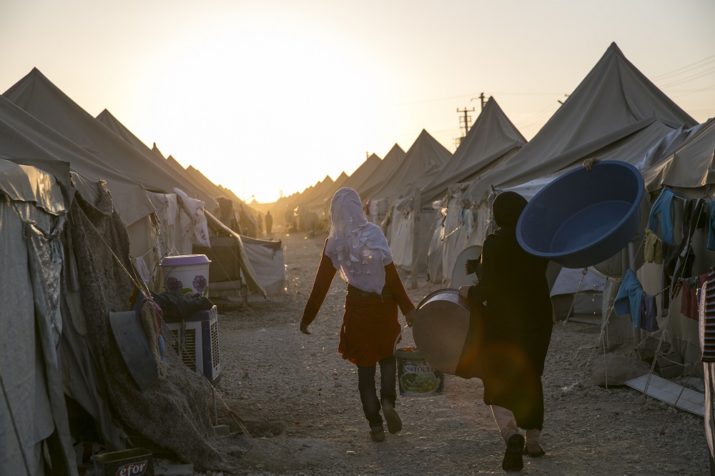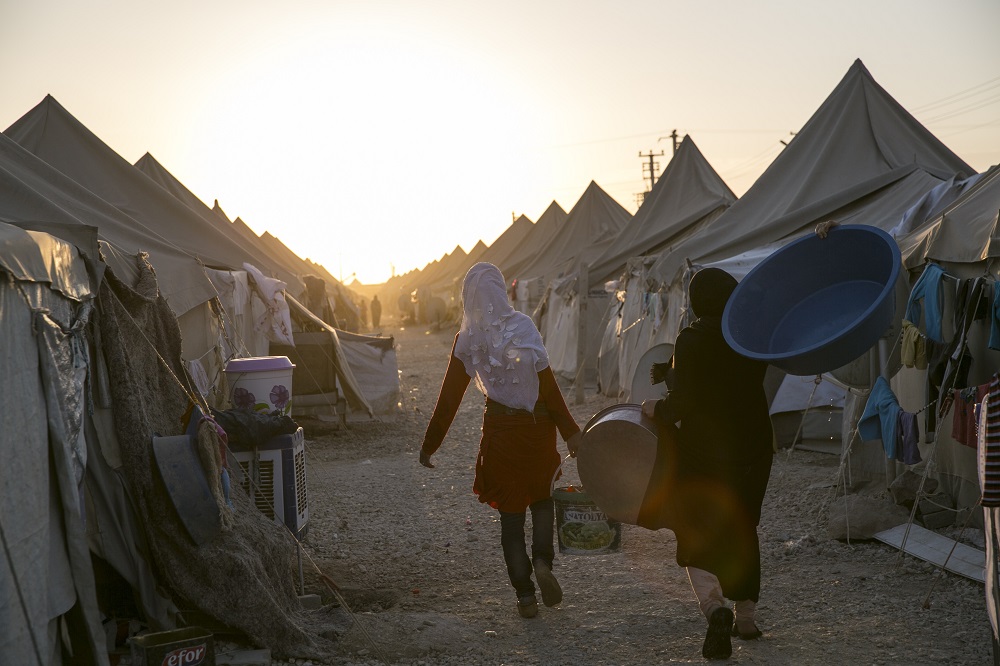

This is part of our special feature, Diversity, Security, Mobility: Challenges for Eastern Europe.
This paper examines how the politics of state, border, and biological control affect the journeys and experiences of asylum seekers and “irregular” migrants who are, at once, the victims and recipients of care and security. Building on fieldwork carried out at the “migrant aid centre” in Porte de la Chapelle, Paris, the harsh realities of the indefinitely displaced in supposedly-liberal democratic spaces reflect not only a disintegrating duty of care, but also the very conditions—and political logics—that make such moves possible. It exposes these practices in terms of biopolitics, the state of exception and humanitarian government; an assemblage of domination that seeks not to provide adequate security to those subjects seeking refuge, but to instead “enhance the biological and emotional well-being of host populations“ (2017, p. 809) which must be innocultated from them.
Bodily Control: The Biopolitics of Racism
It has long been argued by political theorists and philosophers of a certain ilk that the impulse to control life and death is woven into the body politic; activated by the very instruments of governance that not only sustain sovereign power, but effectively construct the identities of those subjects who exist under its control. This is, to borrow from Michel Foucault, the basis of biopolitics: the “State[‘s] control of the biological” (Foucault, 2003, p. 340); the “power to make life live” (and the power, therefore, to let die), and it is, for many, definitive of a modern security milieu in which entire populations can be accessed, recorded, attacked and/or effectively inoculated against that—or those—which might do them harm. The development of biopolitics as a mechanism of state control has necessarily shifted over time; inevitable, given that our understandings of biology, and the body itself have also developed (see Dillon, 2011, p. 180) in tandem with advances in scientific discovery and our ability to measure large collectives of bodies; i.e. populations. In the seventeenth and eighteenth centuries, for example, advances in statistical recording allowed for a more streamlined identification of ‘abnormal’ or ‘deviant’ subjects who could be removed from society and placed into disciplinary (or reformative) spaces, such as the asylum, the prison and the hospital (see Legg, 2009, p. 139). As these technologies progressed—underpinned by an Enlightenment-led logic of scientificity and rationality—populations were conceived in ever-broader and more abstract ways: by birth rates, mortality, longevity (ibid, pp. 139-140) and inevitably, by race—hence, the development of biopolitical racism.
From Foucault’s perspective, biopolitical racism represents not an abhorrence of social cohesion (and, thus an emergency condition to be eradicated), rather, biopolitical racism is constructive to the making of social identities: it furnishes the state’s ability to distinguish between “threatening” and “non-threatening” others, serving as “an expression of a schism within society that is provoked by the idea of an ongoing and always incomplete cleansing of the social body” (Mavelli, 2017, p. 817). In other words, the ability to deny the equal or approximate worth of ‘threatening’ others on the basis of their human coda (appearance, skin colour, accent etc.) sustains a broader sense of security and cohesion that is afforded to the dominant, ‘non-threatening’ host population. This logic can become manifest in a variety of ways, and is surely at its most vicious when the designation of an entire population as ‘threatening others’ activates overwhelming violence to correct this deviation; an act of collective inoculation that is typically referred to as ‘genocide’ or ‘ethnic cleansing’. Read thus, the Holocaust can be interpreted as a most extreme form of biopolitical racism, simultaneously driven by the breathless capacity to deny life, and the technological infrastructure that allows for mass surveillance, classification and ultimate biological control.
Though we often assume that such a horrific event will be forever confined to history, a biopolitical interpretation sees the Holocaust not as a temporal finality, but an example of what Giorgio Agamben calls the “state of exception,” an “original structure in which law encompasses living beings by means of its own suspension” (Agamben, 2005, p. 3, in Zannettino, 2012, p. 1099)[1]. Read thus,
The entire Third Reich can be considered a state of exception that lasted twelve years. In this sense, modern totalitarianism can be defined as the establishment, by means of the state of exception, of a legal civil war that allows for the physical elimination not only of political adversaries but of entire categories of citizens who for some reason cannot be integrated into the political system. (ibid)
While Agamben is speaking here in the context of totalitarianism, the camp nonetheless represents a particular space where the state of exception gradually becomes the rule, trouncing recourse to judicial concepts of fairness and classifying its inhabitants as existing beyond the parameters of humanity (ibid). This, in turn, can make available a range of exceptional disciplinary measures, the enactment of which is typically characterised as ‘inhumane’. If this sounds familiar in the context of migration, it is because—although far from being directly analogous to the horrors of Auschwitz—contemporary asylum seekers, refugees and irregular migrants are beholden to racial biopolitics and a deeply ingrained state of exception that persists not only in enclosed sites such refugee camps, but also in more open, expansive spaces such as oceans, islands and the streets of European cities typically gilded for their promotion of democracy and human rights.
Bodily Harm: The Politics of Humanitarian Government
On the biopolitical racism of refugees, asylum seekers and ‘irregular’ migrants, Luca Mavelli (2017) highlights how liberal democratic regimes engage in a biopolitics of racism that is couched in humanitarian government; that is, the simultaneous deployment of logics of humanitarianism and security. In the case of Australia’s “stop the boats” policy, for example, humanitarian claims to saving lives are justified by the practice of intercepting and re-routing boats before they reach the country’s physical borders; an act of “humanitarian deterrence” that then-Prime Minister Tony Abbot described as “the most compassionate thing you can do”[2]. On the surface, there may appear to be some veracity to Abbott’s claims given that, as Davies and Orchard (2015) point out, there were 300 boats carrying more than 20,000 ‘irregular’ migrants toward Australia in 2013, while in 2014, this number dropped to zero (ibid, in Little and Vaughan-Williams, 2016, p. 534). However, while the “strengthening borders” policy effectively inoculates Australian society from certain “undesirable” entrants, it can and has resulted in grave humanitarian consequences for irregular migrants who are instead detained in islands and states with egregious human rights records, such as Cambodia, Sri Lanka and Vietnam (ibid). This is not to mention those who have been detained under the purview of the Australian state in dreadful conditions on offshore detention centres, such as on Nauru and Manus. In the case of Manus, for example, this is a space in which the UNHCR found that every asylum seeker displayed signs of anxiety and depression[3]; a space in which wells were poisoned, food supplies were destroyed and electricity denied; a space in which a two-week hunger strike by over 500 men saw some inmates sew their lips together and others swallow razor blades[4].
Similar reports have cited the precarious state of life in refugee camps in Greece and Italy, for example, unearthing systemic child exploitation, rape and abuse to the point that Pope Francis has explicitly equated these spaces to “concentration camps”[5]. These experiences are further complimented by familiar tales of abuse in Hungary[6] (where asylum seekers have been kept in ‘transit zones’ comprised of containers, barbed wire fences and a one-way exit route to Serbia)[7]; Bulgaria[8] (where asylum seekers have been detained against their will and “housed” in rotting tents against the backdrop of far-right protests)[9] and further along the Balkan Route, which despite its closure, claimed the lives of 78 asylum seekers from January-June 2017, with drowning, car accidents, hypothermia and suicide among the primary causes[10].
The point here is that although the precise treatment of subjects differs from location to location and across a spectrum of democratic and authoritarian governance, there is little doubt that this collage of suffering—and the biopolitical racism that underpins it—is stitched together by a semi-permanent state of exception that renders inhumane suffering on the most precarious of lives. We have, of course, seen similar examples of this logic enacted throughout history (for as Foucault reminds us, the will to control is always and already embedded in the state), yet what needs to be further highlighted in a contemporary setting is how ‘terrorism’ factors into this assemblage; how it accompanies the simultaneous deployment of security and humanitarianism and how it permeates the greatest forced displacement crisis of our time.
Securing the Body Politic: Borders and Belonging
There is little doubt that the impetus to enhance international border controls was hyper-accelerated in the aftermath of 9/11. In the proceeding months, the calculus of the war on terror became one defined by risk management, with, for example, the USVISIT programme of border controls predicated on biometric recording and the assignment of a “risk score” to individuals attempting legal entry to the United States (see Amoore, 2006, p. 337)[11]. This advance was mirrored in the UK, and subsequently hardened following high-profile terrorist attacks in Bali, Istanbul, Madrid and London (Vaughan-Williams, 2010, p. 1172)[12]. These innovations led international best-practice on border control (including within the EU), exalting modern surveillance and recording techniques to control entry to the sovereign and to swiftly determine—in the perennial shadow of ‘terrorism’—who should be classified as ‘threatening’ and ‘non-threatening’ entities. Read through a lens of biopolitics, 9/11 therefore signifies not so much a singular exceptional event, but a harbinger of a perpetual state of emergency couched in biopolitical racism:
The “unanimism” of the professionals of politics after September 11 created a specific period for the enunciation of a discourse of necessity of war against terrorism and suspicion against foreigners, ethnic and religious minorities, but it was rooted in previous practices. These previous “routines” enable the executive, in so-called time of emergency, to use the justification of prolonged derogatory measures (such as indefinite detention, the demand for longer retention of telecommunications traffic data, introduction of new biometric identifiers in visas, passports and ID cards, as well as the use of transnational exchange of passenger name records) with the argument that it is necessary to act to protect people and to reassure the task of collective survival. This political move is embedded in the expansion of resources for control and monitoring opened by the combination of new technologies reconfiguring the relation between space, time, speed and distance and the will of the bureaucracies of control to use them at their maximum [emphasis added] (Bigo, 2006, p. 49)
It is in this context that previously existing EU border initiatives entered the orbit of counterterrorism (and vice-versa) towards a shared infrastructure of biopolitical border control. Established in 2004, for example, FRONTEX (from frontiers extérieures) established a new external borders agency for the EU, driving: “Co-ordination of intelligence driven operational co-operation at EU level to strengthen security at the external borders” (Neal, 2009, p. 333)[13]; an avatar of the accelerated securitisation of migration that occurred following 2001. In the case of EURODAC—a European database that records and compares fingerprints of asylum seekers—it was initially proposed in 2000 as a mechanism to enforce the Dublin Convention (subsequently the Dublin Regulation), the primary purpose of which is to determine the State responsible for examining an asylum application (normally the state where the asylum seeker first enters the EU)[14]. Following 9/11, however—and up to present day—there have been repeated calls from ministers, police forces, Europol and intelligence bodies across the EU to share the biometric data recorded in EURODAC for counterterrorism purposes. Although this move has been resisted to date, it has faced a renewed groundswell of pressure since the recent high profile Paris terrorist attacks in 2015[15] and a deteriorating situation in Iraq and Syria in particular. Coupled with increasing alarm over the (re)entry of ‘foreign terrorist fighters (FTF) and ‘Trojan Horse’ terrorists masquerading as asylum seekers, it appears likely that an amalgamation of databases that explicitly cross reference ‘counterterrorism’ data and asylum applications will occur in the near future; indeed, a recent European Political Strategy Centre report from the European Commission suggests a forthcoming alignment on this basis[16].
In the meantime, EURODAC and the Dublin Regulation under which it operates represent acute sources of fear among asylum seekers and ‘irregular’ migrants. Far from securing rights and guaranteeing safety, I encountered a number of asylum seekers in my fieldwork who were positively terrified of “giving their finger” or “being Dublined”—and for good reason. In the case of Abdul[17], who had spent the past two months at the Porte de la Chapelle refugee reception centre in Paris (the maximum stay is two weeks), he was waiting to hear if, as a result of being pressured into providing his fingerprint in Bulgaria, he would be returned there by the French authorities. Abdul, and many others, had encountered horrific abuse in Bulgaria, with reports of beatings and dog attacks particularly common; his contingency plan was to sleep on the streets of Paris should he be ordered back to Bulgaria—a similar strategy held in reserve by other asylum seekers throughout the camp. Indeed, the fear of ‘being Dublined’ is well known throughout communities of asylum seekers, and in 2013 a rumour circulated that 13 men had drowned off the coast of Sicily after they jumped overboard upon spotting authorities on shore[18]. A tragic case, if true; but its acceptance as a likely event among the Eritrean refugee community shows the extent to which the fear of being entered into EURODAC is predicated on their expectations of the level of ‘care’ that is to follow.
It is this fear of deportation that has prompted many in Porte de la Chapelle, Paris—and elsewhere, of course—to sleep on the streets and to avoid, at all costs, being returned to oppressive conditions encountered in Bulgaria, Hungary, Serbia elsewhere. Hence, the spontaneous development of a makeshift camp on the streets surrounding the processing centre, which was subsequently razed by police in July 2017[19]. In the absence of emergency sleeping facilities surrounding the camp, asylum seekers and migrants who cannot find a bed in the processing centre have dispersed to parks and sheltered streets throughout the capital, where they’ve reported running the gauntlet of tear gas, batons, dogs and a repressive state apparatus that communicates, in no uncertain terms, that they are not welcome. Set against the backdrop of an officially declared state of emergency—following the November 2015 terrorist attacks—these actions appear to sit somewhere between the rules of “care” afforded by the Dublin Regulations and the markedly increased tendency to disperse crowds under (counterterrorist) emergency powers afforded to the French police—a repeated form of action criticised by Amnesty International, among others[20].
So, where does this leave asylum seekers, refugees and irregular migrants in Europe? Tragically, it suspends them in a familiar space of un-belonging whereby the submission of one’s unique biological identity (the fingerprint) can entail the increased likelihood of erasure; cleansed from the social body as a ‘threatening other’ that is not to be secured, but, rather, secured against. In the shadow of powerful ‘terrorist/refugee’ narrative that anticipates associated individuals in terms of the security threat that they might produce[21], Muslim populations are particularly at risk; for example, states (such as Slovakia, Poland, Hungary, Bulgaria and Cyprus) have either refused to admit Muslim refugees or have expressed strong preferences towards Christian refugees, in order to preserve their own Christian identity (Mavelli, 2017, p. 818). Similarly, some states have justified their flagrance of international norms on the basis of the potential acts of terrorism to be perpetrated at some point in the future, a sentiment neatly captured by Hungarian Prime Minister Viktor Orban: “Migration is the Trojan wooden horse of terrorism…The people that come to us don’t want to live according to our culture and customs but according to their own — at European standards of living… We are still, at this moment, under siege”[22]. Ultimately, it is this notion of failed integration that lies at the heart of a migration crisis defined by biopolitical racism. It is manifest in the rejections and relocations of ‘Dublined’ individuals; it is manifest in the presence of armed guards and muzzled dogs patrolling the perimeters of “welcome centres;” and it is manifest in the crowds of asylum seekers interminably waiting and huddled together on the literal margins of the host society. Speaking with the displaced in Paris, and elsewhere, uncovers a distinct disappointment between the reception many expected, and the harsh reality encountered upon arrival. This situation is damned to repeat itself so long as the liberal democratic approach of humanitarian government represents the default logic of pastoral care and, indeed, biopolitics itself: that is, to give, and at once, to take away.
Dr. James Fitzgerald is Assistant Professor in Terrorism Studies at the School of Law and Government, Dublin City University and co-convenor of the Critical Studies on Terrorism Working Group. He is Programme Co-Director of the International Masters in Security, Intelligence and Security (IMSISS), and principal investigator of the Irish Research Council Project funded Human Stories of Resistance. His current research interests include: everyday resistances to (counter)terrorism; storytelling approaches to international politics; and reflexivity in “academic writing.”
[1] Giorgio Agamben, State of Exception, trans. Kevin Attel (London: University of Chicago Press, 2005), 3.
[2] The Guardian 2015. ‘If Europe listens to Tony Abbott, the future for refugees will be cruel’. 21 April. Available at: https://www.theguardian.com/commentisfree/2015/apr/21/if-europe-listens-to-tony-abbott-the-future-for-refugees-will-be-cruel
[3] See http://www.unhcr.org/en-au/
[4] Doherty, Ben., Davidson, Helen 2017. Australia’s offshore detention regime is a brutal and obscene piece of self-delusion. The Guardian, 29 November. Available at: https://www.theguardian.com/australia-news/2017/nov/30/australias-offshore-detention-regime-is-a-brutal-and-obscene-piece-of-self-delusion
[5] Pullella, Phillip 2017. ‘Pope likens migrant holding centres to ‘concentration camps’. Reuters, 22 April.
[6] As the testimony of Malik from Afghanistan outlines: “They took our clothes and made us sit in the snow and ice – we were frozen. They broke our mobile phones and took our money, and beat us badly.” (Oxfam Joint Agency Briefing Paper, 2017. A Dangerous ‘Game’: The pushback of migrants, including refugees, at Europe’s borders, p. 7. Available at: https://www.oxfam.org/sites/www.oxfam.org/files/file_attachments/bp-dangerous-game-pushback-migrants-refugees-060417-en_0.pdf
[7] http://www.unhcr.org/en-ie/news/latest/2017/9/59b7fb324/visit-hungary-unhcr-chief-calls-end-detention-greater-solidarity-refugees.html
[8] As the testimony of Isaaq of Afghanistan outlines: “The Bulgarian police treated us so harshly that we will never forget it as long as we live – not only me but also all my brothers standing here faced cruelty in Bulgaria. They crossed the limit of cruelty. They put us in a cage, and didn’t give us food for three days. They beat us so badly. They even gave us electric shocks” (Oxfam Joint Agency Briefing Paper, 2017. A Dangerous ‘Game’: The pushback of migrants, including refugees, at Europe’s borders, p. 8. Available at: https://www.oxfam.org/sites/www.oxfam.org/files/file_attachments/bp-dangerous-game-pushback-migrants-refugees-060417-en_0.pdf
[9] The Sofia Globe, 2016. ‘Bulgaria’s Harmanli Refugee Camp: A Timeline of Recent Events’. 28 November. Available at: http://sofiaglobe.com/2016/11/28/bulgarias-refugee-camp-harmanli-a-timeline/
[10] Marcus, Imanuel 2017. ‘Doctors Without Borders’: Bulgarian and Serbian officers used violence against children’, The Sofia Globe. 5 October. Available at: http://sofiaglobe.com/2017/10/05/doctors-without-borders-bulgarian-and-serbian-officers-used-violence-against-children/
[11] Amoore, Louise 2006. Biometric borders: Governing mobilities in the war on terror. Political Geography, 25 (1), pp. 336-351
[12] Vaughan-Williams, Nick. 2010. ‘The UK border security continuum: virtual biopolitics and the simulation of the sovereign ban’, Society and Space, 28 (4), pp. 1071-1083
[13] Neal, Andrew W. 2009. ‘Securitization and Risk at the EU Border: The Origins of FRONTEX’, JCMS, 47 (2), pp. 333-356
[14] http://www.unhcr.org/4a9d13d59.pdf
[15] Paravicini, Giulia 2016. Paris attacks prompt EU to share secrets: European counter-terrorism agencies are overcoming reluctance to work together, Politco, 20 January. Available at: https://www.politico.eu/article/paris-attacks-prompt-share-secrets-eu-security-forces-eurodac-schengen-information-system-terrorism-isis-isil-islamic-state-bataclan/
[16] See: European Political Strategy Centre, 2016. ‘Towards a ‘Security Union’: Bolstering the EU’s Counter-Terrorism Response’. 20 April. Available at: https://ec.europa.eu/epsc/publications/strategic-notes/towards-%E2%80%98security-union%E2%80%99_en
[17] This is a pseudonym.
[18] See Reidy, Eric 2017. ‘No home for refugees in Rome’. 10 November. IRIN. Available at: https://www.irinnews.org/special-report/2017/11/10/no-home-refugees-rome
[19] Chrisafis, Angelique 2017. ‘Police remove 2,000 refugees and migrants sleeping rough in Paris’, The Guardian, 7 July. Available at: https://www.theguardian.com/world/2017/jul/07/french-police-evict-2000-refugees-and-migrants-sleeping-rough-in-paris
[20] Amnesty International, 2017. ‘France: A Right not a Threat: Disproportionate Restrictions on Demonstrations Under the State Of Emergency In France’. 31 May. Available at: https://www.amnesty.org/en/documents/eur21/6104/2017/en/
[21] Fitzgerald, James. ‘Confronting the Terrorist/Refugee Narrative’. EuropeNow, Issue 1. Available at: https://www.europenowjournal.org/2017/01/31/confronting-the-terroristrefugee-narrative/
[22] Gorondi, Pablo 2017. ‘Hungary’s leader calls migration ‘Trojan horse’ of terrorism’. Business Insider, 7 March. Available at: http://uk.businessinsider.com/ap-hungarys-leader-calls-migration-trojan-horse-of-terrorism-2017-3?r=US&IR=T
Published on December 6, 2017.




